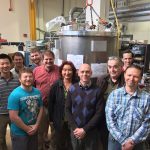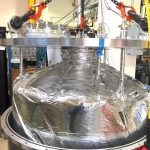It’s been a great summer for undergraduate research in NC State’s experimental nuclear physics group. With our recent acquisition of the PULSTAR cryostat, there is much work to be done, and undergraduate researchers are a great benefit to our research efforts. Here are some highlights:
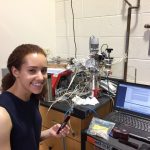
NC State undergrad Monique Martone is working on reducing adsorbed and absorbed H2O contamination in deuterated polymer coatings. She’s also work on developing non-metallic cryogenic origami bellows made from Kapton!
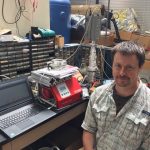 Chad Barrow is part of the TUNL REU program. His research project is to develop a residual gas analyzer based leak checking system using argon for low temperature non-magnetic cryogenics employing plastics and other composite materials.
Chad Barrow is part of the TUNL REU program. His research project is to develop a residual gas analyzer based leak checking system using argon for low temperature non-magnetic cryogenics employing plastics and other composite materials.
Chelsea Mahn, an NCSU undergraduate is working on instrumentation for the PULSTAR systematics studies apparatus. In particular, she’s designing a safety vacuum shut-off valve. She’s also developing LabView algorithms for live data analysis.
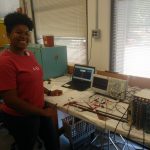 Over at TUNL, Keilah Davis is also part of this year’s REU program. Here, she’s working on linearity studies for the Enge Focal-plane detector’s position-sensitive sections. She’s also developing sophisticated tools to analyze differential cross section data.
Over at TUNL, Keilah Davis is also part of this year’s REU program. Here, she’s working on linearity studies for the Enge Focal-plane detector’s position-sensitive sections. She’s also developing sophisticated tools to analyze differential cross section data.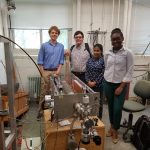
Thomas Chappelow, Clay Fogleman, Deepasika Gedara, and Elon Price (from left to right). Thomas, Clay and Elon are undergraduate students, while Deepasika is a Graduate student. They are developing a pulsed source electron accelerator that will be used to calibrate beta decay detector. The goal of their accelerator is to better understand the Bremsstrahlung losses associated with such detectors.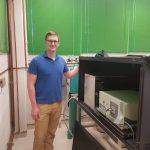
Erik Lutz participates in Raman spectroscopy of solid deuterium to understand it conversion rate from ortho to para states. He is currently upgrading the gas handling system for this Raman spectrometer so that we can mix a volume to introduce a known concentration of a contaminant to a deuterium gas sample.
 Meanwhile, NC State undergraduate Thomas Bailey has been at Los Alamos National Laboratory. In this picture, he’s standing on top of the UCNtau experiment at the Los Alamos Neutron Science CEnter (LANSCE). While at Los Alamos, he has been working on computer modeling of the UCN Source for the Tau experiment and has also been working on the 45Ca experiment taking place in the apparatus behind, which is used for the UCNA/B experiments.
Meanwhile, NC State undergraduate Thomas Bailey has been at Los Alamos National Laboratory. In this picture, he’s standing on top of the UCNtau experiment at the Los Alamos Neutron Science CEnter (LANSCE). While at Los Alamos, he has been working on computer modeling of the UCN Source for the Tau experiment and has also been working on the 45Ca experiment taking place in the apparatus behind, which is used for the UCNA/B experiments.


